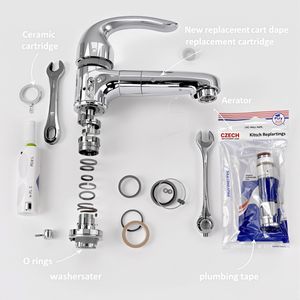How to Fix a Dripping Faucet in 15 Minutes
A dripping faucet isn't just annoying - it can cost you hundreds of dollars yearly. Learn how to fix it easily without calling a plumber.

Transform Your Home Into a Smart Paradise - 2025 Guide
Discover the latest smart home technology that will revolutionize your daily routine.
A dripping faucet is one of the most common household problems. Besides the annoying sound, a single dripping faucet can waste up to 5 gallons of water daily. That means unnecessarily high water bills. The good news is you can fix it yourself in just 15 minutes.
What You'll Need
- Flat-head screwdriver
- Pliers or pipe wrench
- New gasket or entire cartridge (depending on faucet type)
- Cloth to wipe water
- Silicone spray (optional)
Before You Start
Important: Always shut off the water supply first! You'll usually find the main shutoff valve under the sink or in the utility room.
Step-by-Step Guide
1. Identify Your Faucet Type
There are two main types:
- Classic faucet with gasket - has separate controls for hot and cold water
- Lever faucet with cartridge - has one lever controlling both temperature and flow
2. Faucet Disassembly
For classic faucets:
- Remove the cap on top of the faucet (carefully pry with screwdriver)
- Unscrew the screw holding the control handle
- Remove the handle to reveal the valve seat with gasket
For lever faucets:
- Remove the cap (usually behind or under the lever)
- Loosen the hex screw
- Remove the lever and decorative cover
- Unscrew the cartridge using a wrench
3. Replacing Gasket or Cartridge
Gasket replacement:
- Remove the old gasket (usually screwed in or just inserted)
- Clean the valve seat of mineral deposits
- Insert new gasket of the same dimensions
Cartridge replacement:
- Remove the entire cartridge
- Compare with the new one (must be identical)
- Insert new cartridge in correct position
4. Reassembly
Follow the reverse process of disassembly. Tighten all parts carefully - too much force can damage the gasket.
5. Functionality Test
- Turn water back on at the main valve
- Slowly open the faucet
- Check for any water leaks
- Let the faucet run for several minutes
Tips and Warnings
- Tip: Take photos of the disassembled faucet before buying replacement parts
- Tip: Plug the drain with a cloth so you don't lose small parts
- Warning: Never use excessive force - you could damage the threads
- Warning: Older faucets may require complete replacement
When to Call a Professional
- If the faucet still drips after gasket replacement
- When the valve seat is damaged
- For built-in faucets in walls
- If water leaks from the faucet body
Future Prevention
- Regularly clean the faucet of mineral deposits
- Don't use excessive force when closing
- Replace gaskets preventively every 2-3 years
Conclusion
Fixing a dripping faucet is simple maintenance anyone can handle. Investing a few dollars in a new gasket will save you hundreds on water bills. Plus, you'll gain valuable experience for future DIY projects.
Smart Home Upgrade Package 2025
Transform your home with the latest smart technology
Transform Your Home Into a Smart Paradise - 2025 Guide
Discover the latest smart home technology that will revolutionize your daily routine.

